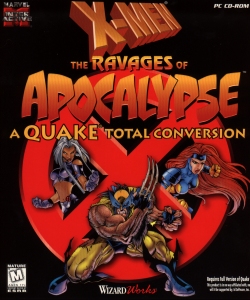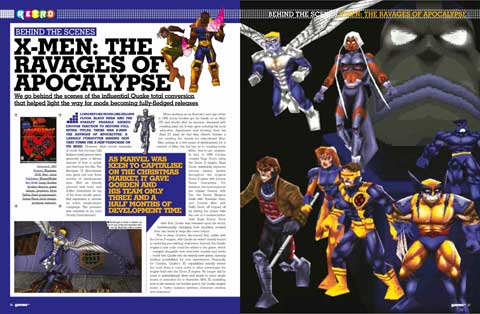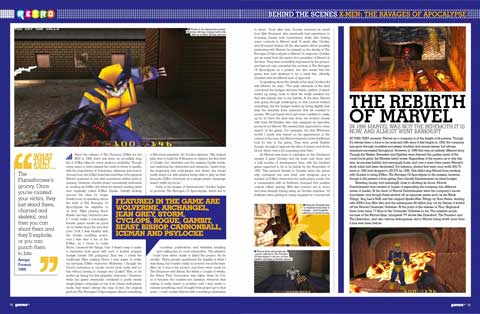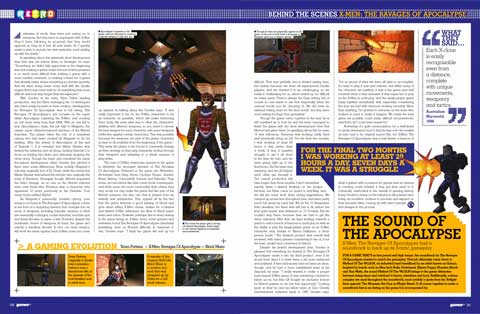Denis Murphy interviewed me for an article in 2017 that happily coincided with the 20th anniversary. Here is the interview, followed by the resulting article.
Can you talk a little about your background prior to working on ROA? What got you into gaming and game creation in the first place?
I was working as an illustrator and sign writer in 1990 when I got an Atari ST. I quickly become hooked on pixel art. Not long after I discovered a branch of the local Education Dept making educational games. I took my Atari in, plugged it into a TV, and luckily got a job. Over the next few years I developed my pixel art and animation skills, I learned about game development, and started learning 3D animation which I enjoyed even more than pixel art.
Prior to Marvel showing interest, why did you decide to create a Quake mod based on the X-Men in the first place? Why did you feel the X-Men franchise could lead to a good FPS?
After playing Tomb Raider one day, I wanted to see if I could make a low-res female game model as good (or better) than the very first Lara Croft. I was familiar with the Quake modding scene, and I was a fan of the X-Men, so I chose to make Storm, and Quake let me test the character.
I learned two things. One, it wasn't easy to make a character look good with such a limited polygon budget (under 500 polys), and two, I loved the challenge.
After making Storm I was eager to make my favorite X-Men character, Wolverine. I thought the Fiend's behavior would work really well for him without having to change any QuakeC files - so he ended up being the first playable character.
I thought Judge Dredd would also work well as a Quake mod, but I decided to continue with X-Men because of the variety of characters, and it was one of my favorite comics.
My original plan was to build the X-Mansion to replace the first level of Quake, but otherwise use the existing Quake levels, just replacing the characters and weapons. I knew from the beginning that multi-player was where this would really stand out, with players being able to play as their favorite X-Men character, so a single-player campaign wasn't really my focus.
Compared to your previous efforts using the Doom engine, as a modder what did the Quake engine offer?
Being 3D was a huge advantage. It takes so long to draw and shade every frame of a Doom character, multiplied by 5 or 8 angles, it gets really tedious (unless you cheat and use photos or 3D models). I prefer 3D because you only have to create the character once. I find it's a much better balance between character creation and animation.
Also of course, Quake was newer and things were advancing so quickly. Quake 2 was already on the horizon, so Doom was very much seen as the previous generation.
Despite it being cutting edge in the 90's, were there aspects of the Quake engine that limited your creativity?
While not specifically a Quake limitation, I would have loved a higher polygon limit. Otherwise, in hindsight there were many limitations, but at the time it didn't feel like that.
How long was the mod in development for before Marvel got in contact with you?
As soon as I started to promote what I was doing, there was a lot of interest. I was getting hundreds of emails, phone calls from America, it was a real rush. Many people questioned the legality of what I was doing, but it hadn't really occurred to me at the time. After all, it was a fan project, and there were mods for the Simpsons and Aliens.
But within a couple of weeks, the Aliens TC was taken down by Fox, so it became the number one question everyone was asking. It really wasn't a problem until I was ready to release something, and I thought when (if) the project got to that point I could contact Marvel with something substantial to show.
About a month later I got an email from Kyle Bousquet who had experience with licensing Quake TC's and had contacts at Marvel. He was interested in helping to negotiate a deal with them. The possibility of actually working with Marvel was a ridiculously exciting prospect for me so I jumped at the opportunity.
A week later we sent Marvel the specs, and the very next day the Senior Vice President called us. Normally they'd put a stop to any projects like this, but they were impressed enough to follow up on this one. They just asked that I password the website until everything was worked out (It ended up being passworded for over 2 months, leading many to believe the project had been "Foxed").
Later that week we heard back from Id Software. They were getting so many requests for commercial releases of mods they were just saying no to everyone. But they were so impressed with X-Men (they'd been following it's progress) that they would approve so long as it had all new levels. So I quickly made a plan to include 2 new episodes, each ending up with 5 levels.
Take us through the discussions you had with Marvel which led to them taking it on as a full release.
The main elements of the deal concerned the budget and time frame, neither of which ended up being close to what we really needed, but that was largely due to my naivety. At the time Marvel was going through bankruptcy, so that loomed behind everything, but the budget ended up being slightly less than the absolute bare minimum that we needed to survive. We just hoped we'd get some royalties to make up for it (LOL from future me).
Once the deal was done, we worked closely with Dave McElhatten who was assigned as Executive Producer for Marvel. We needed their approval for every aspect of the game. For example, the first Wolverine model I made was based on his appearance in the comics at the time, but Marvel wanted a more traditional look for him in the game. They were pretty flexible though, enough to approve the idea of clones, and all the blood which was a bit surprising even then.
On your website you say that Marvel demanded that the game came out before Christmas 1997, which gave you 3 months dev time. For such a small team was this enough time? How did you react to this deadline by Marvel?
The very first conversation with Marvel included the stipulation that they would want a November release. I'd planned to replace all the characters and weapons, but only one level, so that was quite achievable. By the time we'd talked to Id and the scope increased to include 12 new levels, the ball was already rolling.
I had made a very rough schedule for development to be completed in 3 1/2 months which formed the basis of the contract. But that schedule ran from the beginning of June to mid September and, even though there was some development during negotiations, by the time the contract was finalized towards the end of July, that September 15 beta deadline was scary close.
How big did the dev team expand to once Marvel got onboard?
There was myself and Ryan Feltrin leading production, and we were lucky to have Jim Elson to manage the 15 people on the level development team. In total I think 26 people were involved in some capacity, most of whom lived in different cities and worked remotely.
The concept of an X-Men game in which you don't play as the X-Men, and instead kill clones of them, is incredibly ballsy and interesting. Tell us about how you came up with the story that focused on Magneto trying to save world and in turn, the X-Men themselves.
Haha, that's very generous. It was really just my justification for why you're killing a bunch of characters that look and act like X-Men. In hindsight, I think it would have been better to make them robots with replicated powers.
Apocalypse was featuring in the comics at the time, and I thought his shape shifting abilities would make for a great boss character. But my original pitch had Terminus as the final boss, and Dr Doom as the creator of the player character.
In August Marvel asked that Mr Sinister replace Terminus as the final boss because Sinister was well known for cloning (and none of Marvel's editorial team knew who Terminus was). This didn't impact development too much, but my plan was that the world was being destroyed by Terminus as the game progressed, so the resulting levels were a bit less exciting. At the same time Marvel asked that Dr Doom change to Magneto (I guess because he's more involved with the X-Men).
Was the reveal that Mr Sinister was the true main bad guy in the game hidden from the press leading up to the games release, or was this common knowledge?
His name wasn't even in the manual. Not because it was such a dramatic reveal, but I wanted to provide a bit of mystery - an enticement and reward for reaching the end of the game.
Each clone of the X-Men has certain abilities, weaknesses and strengths that tie in with their comic book counterparts. How important was this for you to not just make them mindless cannon fodder? Also, seeing as some X-Men are very powerful, was it challenging to not make them too powerful? How did you balance keeping them true to their characters without making the game incredibly hard?
It was really important to me for the characters to be as authentic as possible, which did make balancing them tricky. My main idea was to offset the character's abilities with different weapons, so you need to choose the best weapon for each character, with some weapons ineffective against certain characters. This was possible because the weapons are part of the player character, so they're all available from the beginning of the game.
I think the game did end up too difficult. That was partially due to limited testing time, but mainly because we were all experienced Quake players, and we wanted it to be challenging so we made it challenging for us, which ended up too difficult for many users. There's always the easy setting, but of course no-one wants to use that (especially when the manual mocks you for choosing it).
We did have an external testing team for the final month, but they were more testing for bugs than gameplay.
Seeing as you had 3 months dev time, how hectic was it to get the game finished?
It was ridiculous. Everyone was working really hard and practically living on Jolt. For the final 2 months I was working at least 20 hours a day, 7 days a week. It was a massive struggle to get it all done in the time we had, and we were going right up to the final hours. But the team was amazing and we all helped each other get through it.
The overall production did take longer than 3 months. I don't remember exactly when I started working on the project full time, but Ryan came on board in mid May and we did get some work done during negotiations. We ramped up production throughout June, and were pretty much full steam by early July. We hit the Sept 15 beta deadline, but there was still lots to do before the final gold master was delivered on October the 15th.
But we couldn't stop there, because then we had to get the demo released. After that we kept working towards a patch to add a bunch of features to multi-play as well as the ability to play the single player game as an X-Men character and, thanks to Ryan's brilliance, a 3rd person mode.
During development did you face any issues, technical or otherwise?
Too many to mention :)
Something we didn't fully appreciate in the beginning was that making a game under that sort of time pressure is so much more difficult than making a game with a more realistic schedule or making content for a game that already exists, where everything is a known quantity. And we were doing some crazy stuff with the Quake engine that it was never built for. So everything was more difficult and took way longer than we expected.
Was there anything that you wanted in the game that you couldn't fit into the 3 months of dev time?
In terms of the Quake TC, everything I wanted was in there, but I definitely would have liked more time for polish and balance.
But there was so much more that I wanted to do, that I knew from the beginning couldn't be included in "X-Men Quake". I really wanted to make a proper team based X-Men game, but that would have taken way more time, money and a more established team. I started planning a stand-alone sequel, but then Activision bought an exclusive license for Marvel games so we lost that opportunity.
Looking back, how do you now view ROA?
I'm so proud of what we were all able to accomplish. It's easy to play it now and criticize, and while many of the criticisms are justified, it was a fun game and well received when it was released. It was super fun to play as the X-Men in multi-play, and the single player game hung together remarkably well, especially considering the time we had with everyone working remotely.
More than anything I'm grateful to everyone on the team who worked so hard to make it happen. We made the best game we possibly could under difficult circumstances, and that's all I could have hoped for.




